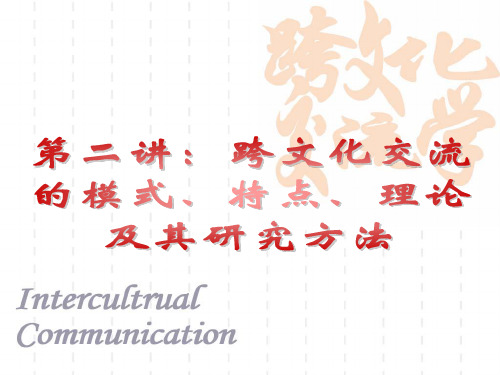跨文化交际的特点
非语言表达在跨文化交际中的特点和作用

非语言表达在跨文化交际中的特点和作用跨文化交际是一种复杂的交流活动,它不仅要求双方了解彼此的语言,而且还要求双方需要运用非语言因素来实现交流。
非语言表达成为跨文化交际过程中不可缺少的一部分。
本文将从三个方面讨论非语言表达在跨文化交际中的特点和作用。
首先,非语言表达能够在跨文化交际中起到替代作用。
跨文化交际当中,双方往往拥有不同的语言背景,在不同的文化环境下,同一个词语可能有不同的定义,一句话可能有不同的解释,因此,对于双方理解的词语或概念,要尽量使用非语言表达,如手势、表情、动作或仪式等,以便于更好地达成沟通,降低误解。
其次,非语言表达在跨文化交际中可以承载更多的文化内涵。
不同文化背景所拥有的历史、习俗、信仰或礼仪等文化内涵不能准确的表达于一句话中,可以通过非语言表达及一些仪式,让双方更好的了解彼此的文化差异,以此构建起一座桥梁,加深双方之间的交流。
最后,非语言表达能够补充语言表达,从而提高沟通的效果。
有时,单纯通过讲话无法表达出情感上的真实意义,而非语言表达,如眼神、表情等,则可以帮助双方更全面地了解对方的真实想法,从而实现更深层次的沟通。
通过以上讨论,可以看出非语言表达在跨文化交际中扮演着重要的角色,它不仅可以替代语言,减少误解,还能传达出彼此所不能直接用语言表达的文化内涵,更有助于双方的沟通效果。
然而,双方在运用非语言表达时也应当注意文化差异,避免造成误解或不必要的沟
通障碍。
总的来说,双方需要多多体现文化的尊重,努力提高沟通技巧,以促进更加有效的跨文化交际。
跨文化交际的问题与解决研究

跨文化交际的问题与解决研究随着全球化的加速和国际交往的不断加深,跨文化交际问题已然成为我们生活中不可避免的一部分。
在跨文化交际中,我们往往会面临各种挑战和问题,比如语言障碍、文化差异、沟通方式不同等等。
为了更好地解决这些问题,我们需要深入研究跨文化交际的本质和特点,并探索有效的解决方法。
一、跨文化交际的本质和特点跨文化交际是指在不同文化背景下的交际活动,涉及到的人群、语言、文化等都存在较大的差异。
跨文化交际的本质是不同文化之间的交流和互动。
在跨文化交际过程中,我们需要通过语言、视觉、肢体语言等方式进行沟通,同时理解和尊重不同文化之间的差异和特点,以达到和谐共处和合作。
跨文化交际的特点主要有以下几个方面:1. 多样性:不同国家和地区之间存在着各种语言、文化和传统,人们在跨文化交际中需要面对多元的差异性和复杂性。
2. 动态性:跨文化交际不是一成不变的,随着社会、历史和经济等因素的变化,跨文化交际需要不断地适应和调整。
3. 矛盾性:不同文化之间的差异和冲突是不可避免的,跨文化交际需要协调和解决各种矛盾问题。
二、跨文化交际中常见的问题在跨文化交际中,我们需要面对各种各样的问题,下面列举了一些常见的问题:1. 语言障碍:不同国家和地区之间存在着各种语言,语言障碍是跨文化交际中最基本的问题。
2. 文化差异:不同文化之间存在着种种不同,如礼仪、宗教、道德等方面的差异,这些差异可能会导致误解或矛盾。
3. 沟通方式不同:不同文化之间的沟通方式和表达方式也存在差异,如在中国,说话时一般比较委婉、含蓄,而在美国,人们则更注重直接表达和说话技巧。
4. 价值观不同:不同文化之间的价值观存在着差异,如在西方国家,人们更注重个人的自由和权利,而在亚洲国家,人们则更重视集体意识和家庭观念。
三、跨文化交际的解决方法如何在跨文化交际中解决上述问题,使得交流和合作更加顺利呢?以下几点可以作为参考:1. 学习对方的语言和文化:学习对方的语言和文化是解决跨文化交际问题的基本方法,能够更好地理解对方的观念和行为方式。
跨文化交际

名词解释1.跨文化交际①所谓跨文化交际,即指不同文化背景的人们之间的交际。
也就是说,所谓跨文化交际,实际上是包含了许多不同的维面,如跨种族交际、跨民族交际、同一主流文化内不同群体之间的交际、国际性的跨文化交际等等。
②在特定的交际情景中,具有不同的文化背景的交际者使用同一种语言(母语或目的语)进行的口语交际。
这个概念界定是明确的,它是立足于对外汉语专业的需要而定的,因而与一般的跨文化交际概念是有区别的。
③跨文化交际的学科背景包括文化语言学,社会语言学,言语交际学.④跨文化交际对于有些人来似乎说是一个新词,可实际上,我们经常在从事跨文化交际,只是我们不自觉而已。
例如:我们给外国游客指路、和留学生交往、阅读外国小说、看外国电影电视等等,都是不同形式的跨文化交际。
2.文化定势世界上大多数社会中都可能存在着若干群体或社团,这些群体或社团对地域、历史、生活方式以及价值观等方面的共享,使其成员形成、发展并强化了自己独特的文化及与之相适应的交际文化。
在跨文化交际研究中,学者们往往倾向于把某一文化群体的每一个成员都视为该文化定势的代表或整体文化形象。
这种整体式的文化取向通常被称为文化定势。
3.价值观①在跨文化交际研究中,价值观是个至关重要的问题。
价值观是文化的底层,不理解其差异就不能理解不同文化之间的根本差异。
②价值观对人类的活动起着规定性或指令性的作用,是人们行为的规则、思维的方式、认知的准绳、处世的哲学、推理的模式、评价的依据、道德的标准。
人们在不知不觉中通过交际习得这套价值系统,它变成了他们的集体无意识,变成了他们的信仰、心态、行为、生活等诸方面的可评价系统,变成了他们民族性格的基石。
每一种文化都有其独特的一套系统,而价值观是它的核心。
③价值观总是相对稳定的,一个人的价值观是从出生开始,在家庭和社会的影响下逐步形成的。
一个人所处的社会生产方式及其所处的经济地位,对其价值观的形成有决定性的影响;同时舆论宣传,以及父母、老师、朋友和公众名人的观点与行为,对一个人的价值观形成也有不可忽视的作用4.体态语体态语(body language )是非语言交际的重要组成部分,它包括眼神、手势、身势、面部表情、体距、体触等。
跨文化交际知识点汇总

一、跨文化交际概论1.什么是跨文化交际?跨文化交际是不同文化背景的人们之间的交际。
一个层面指不同国家和民族的人们之间的交际。
另一个层面指同一个国家或民族中,不同性别、年龄、职业、地域的人们之间的交际。
2.跨文化交际的特点是什么?跨文化交际主要指人与人、面对面的交际;跨文化交际中涉及很多差异性;跨文化交际容易引起冲突;跨文化交际的误解和冲突大多属于“善意的冲突”;跨文化交际常常引起情绪上的强烈反应;跨文化交际是一种挑战,更是一种收获。
3.国际汉语教师为什么要学习跨文化交际学?国际汉语教师学习跨文化交际的必要性体现在:更好地理解中国文化;建立敏锐的跨文化意识;提高文化适应能力;建立开放、宽容、尊重的文化态度;提高在不同文化环境中进行汉语教学的能力;掌握培养学习者跨文化交际能力的方法和策略。
4.跨文化交际主要学习内容有哪些?文化与交际;价值观与文化模式;语言交际;非语言交际;文化身份&认同;文化适应;跨文化交际的心理因素;不同领域的跨文化交际;跨文化交际能力;跨文化交际训练。
二、交际与文化1.什么是文化?关于文化的定义,学界至今未有统一的定论。
而作为跨文化交际的学习者,我们最关心的并不是哪位学者提出的文化定义最全面、最精确,而是哪个文化定义与跨文化交际最相关,最能体现文化与跨文化交际的关系。
教材推荐跨文化交际学者Brislin(2000)的文化定义:文化是大多数说同一种语言和住在一起的人们所分享的价值和观念,这些价值和观念是世代相传的而且为人们提供对日常行为的指导。
2.什么是文化要素?文化要素包罗万象。
其中与跨文化交际关系最为密切的是历史、宗教、社会组织、语言。
理解这些文化要素,有助于我们理解文化在跨文化交际中的影响和作用。
3.G. Hofstede与 G.J.Hofstede(2004)提出的文化要素包括几个层次?包括象征符号、英雄人物、礼仪、价值观4个层次。
4.在跨文化交际领域,常用的文化分类方法有几种?分别是什么?有两种文化分类的方法在跨文化交际领域最为常用。
跨文化交际特点

跨文化交际特点
1. 跨文化交际特点之一就是多样性啦!就像一个大花园里有各种各样的花朵,不同文化就是那些色彩斑斓、形态各异的花儿。
比如,在我们的文化里见面可能会握手,而在有些地方却是拥抱甚至亲吻脸颊呢,这多有意思呀,不是吗?
2. 还有啊,语言障碍有时候真是个大难题!这就好比爬山时遇到的陡峭山峰。
想想看,当你和一个语言不通的人交流,那不就像在迷雾中摸索嘛。
但也正因为这样,才让我们更努力去理解和学习呀!
3. 文化差异也会导致行为习惯不同哟!好比不同的菜系有着独特的风味。
像有的地方吃饭用筷子,有的地方用刀叉,我们要试着去适应和尊重这些差异,才能真正融入不同文化呀!
4. 跨文化交际中,理解和包容可太重要啦!这就像是船只在大海上航行的灯塔。
比如面对不同的宗教信仰和习俗,我们如果不理解和包容,那不就会产生冲突了嘛,那多糟糕呀!
5. 礼貌表达方式的不同也是一个特点呢!就好像不同风格的衣服。
在一种文化里被认为礼貌的话,在另一种文化里可能就不一定咯,我们得小心注意呀!
6. 情感表达也有差别呢!像不同的音乐旋律。
有的文化可能比较含蓄,有的文化则很奔放。
我们要学会感知这些不同,才能更好地与人交流呀,对吧!
总之,跨文化交际充满了奇妙和挑战,我们要怀着开放和好奇的心去面对,才能真正领略到它的魅力呀!。
跨文化交际下中韩文化的异同

跨文化交际下中韩文化的异同关键词:跨文化交际;中韩文化;比较引言中韩两国历来有着良好的跨文化交际传统,交际活动涵盖多个方面,两国文化领域存在着较明显的共性,促进了文化交流和彼此了解,增进两国间的民族感情。
为了更好地促进中韩跨文化交流,我们不仅需要充分利用两种文化的契合点,还需要了解并尊重不同文化间的价值观差异和民族性格差异,从而提高跨文化交际实效。
一、跨文化交际简述1.跨文化交际的解释我们将具有两种或两种以上文化背景的主体放在特定的交际场景,使用同一语言从事的口语交际活动称为跨文化交际。
需要强调的是,交际主体的异文化背景、各主体使用同一语言以及口语交际模式是跨文化交际的三个重要特点。
首先,跨文化交际主体的异文化背景,表现在中韩两国之间的跨文化交际上,分别为华夏文化背景、韩文化背景,两者都是东方文化的代表,有着明显的儒家文化基因,但在细节上,如语言、文字、表达方式以及生活习性、风土人情等方面表现出明显的差异性。
其次,由于异文化背景产生不同的语言,为跨文化交际形成语言障碍,使用同语种交际要求是基于信息传达和理解的需要。
如中韩文化交流中可采用汉语、韩语以及第三方语言为交流语种。
此外,跨文化交际还包括物化形式、传媒形式、书面形式交际方式,面对面的口语交际最具实效性。
2.跨文化中的文化因素影响文化因素产生于文化背景,延伸到文化生活的各个层面,表现为价值观和社会规范以及民族性格等方面。
影响跨文化交际实效的因素主要包括价值观差异、民族性格差异。
不同文化背景造就跨文化交际中的差异性,如中韩两国在传统节日上,都有春节、元宵、端午和中秋四大传统节日,但中国人更重视春节,韩国人更重视中秋节;在传统节日习俗上如节庆方式、饮食、重视程度以及情感寄托各不相同。
在跨文化交际过程中,这些都是影响交际活动的文化因素,需要交际双方加以重视。
二、中韩民族性格的共性和差异性分析1.中国民族性格特点民族性格是社会文化底蕴和精神面貌透过意识层面的外在表现,表现为行为习惯和心理反应的总和,受政治、经济、文化等因素影响,具有较高概括性和辨识度,如美国人大方、日本人守礼、德国人一丝不苟、中国人热情、犹太人富足等,都是在共性基础上提取的民族性格特点。
文化的定义跨商务文化交际

商务环境中的沟通障碍与解决方式
误解与偏见
由于文化背景的差异,可能导致 对对方行为的误解和偏见。
缺乏共同语言
不同文化背景的人可能使用不同 的语言或术语,导致沟通困难。
沟通风格不同
不同文化背景的人Hale Waihona Puke 能有不同的 沟通风格,如直接或委婉。
适应沟通风格
根据对方的文化背景调整自己的 沟通方式。
跨商务文化交际是指在不同 文化背景下的商务交流和合 作。成功的跨商务文化交际 需要具备文化意识和跨文化 沟通能力,以促进相互理解 和合作。
文化差异对商务交流和合作 产生重要影响,包括语言沟 通、谈判技巧、决策方式等 方面。因此,在跨商务文化 交际中,需要充分了解和尊 重文化差异,以避免误解和 冲突。
文化的重要性
01
02
03
促进社会和谐
文化是社会凝聚力的源泉, 它有助于形成共同的社会 规范和价值观,促进社会 和谐与稳定。
塑造个体行为
文化对个体的思想、行为 和价值观产生深远影响, 塑造个体在社会中的角色 和行为方式。
推动经济发展
文化作为一种产业,能够 创造经济价值,推动经济 发展和社会进步。
文化的影响因素
非语言信息差异
肢体语言、面部表情等非语言信息在不同文化中 可能有不同的含义,可能导致沟通障碍。
语言障碍
语言是跨文化交际的核心媒介,但不同语言的语 法、语义、表达方式等方面存在差异,可能导致 信息传递的误解。
应对策略
尊重文化差异,增强文化敏感性和包容性;学习 并掌握目标文化的语言和非语言信息;培养有效 的沟通技巧,如倾听、表达和反馈;利用专业机 构和人士进行跨文化培训和指导。
跨文化交际 知识点整理

第一章.跨文化交际概论1跨文化交际汉语国际教育本质上是一种跨文化的活动。
新世纪如此广泛而深入的跨文化交际主要是受到以下因素的影响1.交通和通信技术的发展2.经济的全球化3.人口的流动4.广泛的国际交流与合作什么是跨文化交际?跨文化交际既是一种人类的社会活动,也是指一门研究跨文化交际活动的学科。
根据几个定义归纳出跨文化交际的重要特点:1.跨文化交际是不同文化背景的人们之间的交流;2.跨文化交际是通过象征符号来实现的;3.跨文化交际是一种动态的过程4.跨文化交际是一种双向的互动;5.跨文化交际的目标是创建共享的意义跨文化交际是不同文化背景的人们之间的交际,这里的跨文化交际实际上包含着两个层面一个层面是指不同国家和不同民族的人们之间的交际,例如中国人与美国人等另一个层面是指同一个国家或民族中,不同性别、年龄、职业、地域的人们之间的交际,例如男性和女性之间的交往就可以被看做是一种跨文化的交往跨文化交际的特点1.跨文化交际主要指人与人之间面对面的交流面对面的交流既包括了语言交际也包括了非语言交际,而且是一种双向交流和互动的过程2.跨文化交际中涉及很多差异性(陈国明)差异可以是文化传统、价值观、信仰等方面的差异,也涉及行为方式和习俗方面,如手势、衣着、语言使用的差异,同时也涉及个人文化身份和社会角色方面的差异。
这些存在差异的因素相互作用,影响了跨文化交流的过程和结果3.跨文化交际容易引起冲突由于语言、交际风格、非语言行为、思维模式、社会准则、价值观等方面的差异,跨文化交际很容易产生误解和冲突4.跨文化交际的误解和冲突大多属于“善意的冲突”许多冲突往往不是出于人们恶意的动机,而是来源于人们良好的愿望。
在自己文化中得体而礼貌的行为到了另一种文化中却成了无礼的举动,善良的意图却产生了意想不到的误解和不愉快5.跨文化交际常常引起情感上的强烈反应很容易造成心理紧张,人们经常提到的“文化休克”就是形容在跨文化交际中产生的心理反应。
跨文化交际

1、跨文化交际:具有不同文化背景的人从事交际的过程就是跨文化交际,跨文化交际是自古以来就存在的现象,今天日益引起人们的注意主要原因是交通工具的进步与通讯手段的发展使得不同国家、不同种族、不同民族的人能够频繁地接触和交往。
全球经济持续快速发展也为跨文化交际提供了坚定的物质力量。
2、你认为强调个人间的文化差异有什么利弊?利:每个人都隶属于若干群体,即使在同一群体中每个人的态度、价值观也不会完全一样,因此,每个人都应该被认为是独特的,强调个人的差异,就是在从地区、职业、年龄、性别等方面来研究不同文化对个体的影响,这有助于跨文化交际深入开展。
弊:然而,过于强调个人间的文化差异也有一定弊端,个体只是一种或多种文化的具体情况,根据传统的观念,文化通常不是指个人行为,而是指一个群体的生活方式和习惯,个人间的差异研究只有在我们把他们当作群体代表时才有意义,没听过“个人文化”的说法。
过分强调个人文化间的差异会使跨文化交际变得非常繁琐,实际上取消了跨文化研究的意义。
3、我国的地区文化是否可以作为跨文化交际研究的重要方面?跨文化交际研究的重要性排序如下:主流文化——亚文化——地区文化——小群体文化。
地区文化的差异是跨文化交际研究的重要课题之一。
我国幅员辽阔、地域广袤,地势高低起伏,地形复杂多变,由于空间分布差异,各地区形成了具有各自地方特色的区域文化。
同时,我国是一个多民族国家,每个民族都有自己的民族文化传统,这些也构成了地区文化的一部分。
这些地区文化,从总体上看,特点显著,区别性强,差异性大,值得进行跨文化研究。
4、跨文化交际为什么产生在美国?①美国是一个移民国家,各民族都有各自的文化传统和风俗习惯,各民族都强调维护自己的文化,于是在美国形成了多元文化的格局,如何处理不同文化习俗和价值观念成为不容忽视的问题。
②美国与各国交往频繁,每年大批政府官员、商人、技术人员奔赴世界各地,与当地人有着各种不同的接触,而美国每年又接待大批的留学生、移民和旅游者,对于留学生和移民的训练也是跨文化交际中的一个重要课题。
跨文化交流的模式、特点及理论

四、研究的三种方法
1、社会科学的方法(social science,有时称 为functionalist)
2、 描述性方法(interpretive approach)
3、评论性方法(critical approach)
研究跨文化交流的方法
社会科学法 所依赖的学科 研究的目的 对现实的假设 对人类行为的 假设 心理学 描述和预见行为 外部的 描述性的 可预见性的 描述法 文化人类学 社会语言学 描述行为 主观的 创造性的 随意的 评论法 多种学科 改变行为 主观的 可变化的
国际关系学 文化人类学、社会学 语言学 哲学 心理学
犹如洋葱头
图2.11
观察跨文化交流各理论的层面
2、跨文化交流学的各种理论
(1)传播学:减少不确定性理论 (2)心理学:归因理论
(3)语言学:修辞学理论 (4)哲学:世界观、人生观、价值观 (5)文化人类学:文化规范冲突理论 (6)社会学:适应理论 (7)国际关系学
图 2.4
(2)跨文化传播的模式(A) 发送者 编码 传递信息 接收者 解码 阐明 正确 编码反馈信息 图 2.5 解码 阐明
无 误 会 反 馈
误 会 反 馈
不正确 编码反馈信息
模式(B)
发 送
发送信息 信 息 ○ 渠 道
○ ○
编码 甲 (依据甲文化码本和程序)
(反应) 意向 (反应) ○ □ 化 使原意改变 与原意重合 文 发 解码 (依甲文化码本和程序) 送 者
100 %
美国/法国 美国/德国 美国/意大利
0 % 美国/英国 美国/加拿大 0 %
图2.10
不同文化的差异程度
2、跨文化交流中注意的问题:
(1)两种文化的异同与互动 (2)两种文化的冲突点 (3)文化发展的变异 (4)文化的依附与独立
跨文化交际在国际商务中的重要性

跨文化交际在国际商务中的重要性第一章: 引言随着全球化的深入发展,国际贸易越来越繁荣。
与此同时,跨文化交际在国际商务中的重要性日益凸显。
在国际商务中,由于涉及到不同的文化背景和语言环境,跨文化交际扮演着关键的角色。
本文将介绍跨文化交际的相关概念、特点以及在国际商务中的应用。
第二章: 跨文化交际的概念和特点2.1 跨文化交际的概念跨文化交际是指在不同的文化背景和语言环境下进行的交流活动。
在跨文化交际中,不同的文化背景和语言环境会对双方的思维方式、信息处理方式、语言表达方式等方面产生影响,从而会影响跨文化交际的成功率。
2.2 跨文化交际的特点跨文化交际具有以下几个特点:1)在跨文化交际中,不同的文化背景和语言环境会对信息的传递和理解产生影响,从而容易产生误解和文化冲突。
2)跨文化交际中的成功不仅取决于语言水平的高低,还取决于双方的文化素质和文化适应能力。
3)跨文化交际需要双方具备开放的心态和较高的文化自觉性,以便更好地理解和尊重双方的文化差异。
第三章:跨文化交际在国际商务中的重要性3.1 提升商务合作的成功率在国际商务中,跨文化交际能够提升商务合作的成功率。
由于涉及到不同的文化背景和语言环境,如果没有跨文化交际的支持,容易产生误解和文化冲突,从而影响商务合作的开展。
因此,在跨文化交际的支持下,双方可以更好地理解对方的需求和要求,从而提升商务合作的成功率。
3.2 减少商务风险在国际商务中,跨文化交际能够减少商务风险。
由于不同的文化背景和语言环境的影响,容易产生误解和文化冲突,从而导致商务风险的发生。
通过跨文化交际,双方可以更好地理解对方的需求和要求,从而减少商务风险的发生。
3.3 增强国际竞争力在国际商务中,跨文化交际能够增强企业的国际竞争力。
由于涉及到不同的文化背景和语言环境,如果没有跨文化交际的支持,容易导致企业在国际市场上丧失竞争力。
因此,在跨文化交际的支持下,企业可以更好地理解和适应不同的文化背景和语言环境,从而增强企业的国际竞争力。
跨文化交际知识点汇总

一、跨文化交际概论1.什么是跨文化交际?跨文化交际是不同文化背景的人们之间的交际。
一个层面指不同国家和民族的人们之间的交际。
另一个层面指同一个国家或民族中,不同性别、年龄、职业、地域的人们之间的交际。
2.跨文化交际的特点是什么?跨文化交际主要指人与人、面对面的交际;跨文化交际中涉及很多差异性;跨文化交际容易引起冲突;跨文化交际的误解和冲突大多属于“善意的冲突”;跨文化交际常常引起情绪上的强烈反应;跨文化交际是一种挑战,更是一种收获。
3.国际汉语教师为什么要学习跨文化交际学?国际汉语教师学习跨文化交际的必要性体现在:更好地理解中国文化;建立敏锐的跨文化意识;提高文化适应能力;建立开放、宽容、尊重的文化态度;提高在不同文化环境中进行汉语教学的能力;掌握培养学习者跨文化交际能力的方法和策略。
4.跨文化交际主要学习内容有哪些?文化与交际;价值观与文化模式;语言交际;非语言交际;文化身份&认同;文化适应;跨文化交际的心理因素;不同领域的跨文化交际;跨文化交际能力;跨文化交际训练。
二、交际与文化1.什么是文化?关于文化的定义,学界至今未有统一的定论。
而作为跨文化交际的学习者,我们最关心的并不是哪位学者提出的文化定义最全面、最精确,而是哪个文化定义与跨文化交际最相关,最能体现文化与跨文化交际的关系。
教材推荐跨文化交际学者Brislin(2000)的文化定义:文化是大多数说同一种语言和住在一起的人们所分享的价值和观念,这些价值和观念是世代相传的而且为人们提供对日常行为的指导。
2.什么是文化要素?文化要素包罗万象。
其中与跨文化交际关系最为密切的是历史、宗教、社会组织、语言。
理解这些文化要素,有助于我们理解文化在跨文化交际中的影响和作用。
3.G. Hofstede与 G.J.Hofstede(2004)提出的文化要素包括几个层次?包括象征符号、英雄人物、礼仪、价值观4个层次。
4.在跨文化交际领域,常用的文化分类方法有几种?分别是什么?有两种文化分类的方法在跨文化交际领域最为常用。
跨文化交际的特点分析

跨文化交际的特点分析国际间日益频繁的政治经济等各个方面的往来使得跨文化的交往成为时代的必需。
深入细致地对跨文化交际的特点进行分析是跨文化交际研究的基础。
只有对跨文化交际中的双方文化共享性、各种文化的差异程度、先入为主的意识、矛盾与冲突的现状、文化的变异性等有了充分的了解,才能够进一步研究如何跨越文化的障碍,完成有效的跨文化交际。
标签:跨文化交际特点语言跨文化交际对于许多读者来说是已经不是一个新词。
尤其近年来,随着国际间的文化交往越来越频繁,跨文化交际的机会越来越多,跨文化交际已经成为被一个大家普遍接受的词汇。
领导人进行政治谈判是在进行跨文化交际,与外国商人谈生意也是在进行跨文化交际,去国外旅游、留学或接待来旅游、来留学的外国人是在进行跨文化交际。
在互联网上与外国人聊天也是在进行跨文化交际。
实际上,可以说具有不同文化背景的人从事交际的过程都是跨文化交际。
对跨文化交际特点的研究有利于较少跨文化摩擦,避免交际失误,有效完成跨文化交际实践。
分析表明,跨文化交际具有以下特点:一、双方文化共享性差共享性是指人们具有共同的文化特征,在交流学中是指人们对同一客体给予和享有的共同编码。
同文化交流与跨文化交流的基本区别在于前者的交流双方共享同一文化,而后者的双方则是来自不同文化背景的主体(个人、群体或国家),其各自的文化中的队知体系、规范体系、社会组织、物质产品、语言符号与非言语符号系统的相似与不同混淆在一起,其文化共享性差。
编码本不同表现在多方面。
以语言符号为例:其一,编码的发音和形状不同。
例如,汉族人把自然界中的清晨东升,傍晚西落的发光的球状天体编码为“太阳”,而英国人把它编码为sun”。
其二,是词汇量不同。
例如,甲种编码本有2万个收词量,乙种编码本有2.5万个收词量。
汉语中形容烹调方法的字有50多个,如烤、烧、蒸、煨、炖、煮、炸、煎、炒、烩、熏、煲、烘、焙、熬、涮、溜、氽…而英文用以形容烹调方法的词,大约只有10余个,例如,bake(烤),broil(用猛火烤),barbecue(烧),steam(蒸),stew(用文火慢慢煨炖),boil(用白水煮熟,汤通常弃之不要),simmer(用文火短时间的炖煨),deep fry(炸),panfry(介于炸与煎之间),stir fry (炒)。
对跨文化交际的理解与认识

对跨文化交际的理解与认识一、引言跨文化交际是指不同文化背景的人之间进行交流和沟通的过程。
在当今全球化的背景下,跨文化交际已经成为一个日益重要的话题。
跨文化交际不仅涉及到个人生活中的各个方面,也是企业、政府和国际组织等机构开展国际合作的重要基础。
本文将从多个角度对跨文化交际进行分析和探讨。
二、跨文化交际的定义1. 跨文化交际的概念跨文化交际是指在不同国家或地区,使用不同语言和符号系统的人之间进行信息传递、意见交流以及价值观念传递等活动。
2. 跨文化交际的特点(1)多元性:涉及到多种语言、多种符号系统、多种价值观念等。
(2)复杂性:涉及到社会制度、政治体制、历史背景等因素。
(3)动态性:随着时代发展和社会变革,跨文化交际也在不断变革。
三、影响跨文化交际的因素1. 语言差异语言是人类最重要的沟通工具之一,但不同语言之间存在差异。
这些差异可能包括语音、语法、词汇、文化背景等方面。
2. 文化差异不同的文化背景会影响人们的价值观念、信仰、习惯和行为方式等方面。
这些差异可能会导致误解和沟通障碍。
3. 社会制度和政治体制社会制度和政治体制也会影响跨文化交际。
例如,在某些国家或地区,政府对媒体进行严格控制,这可能会影响信息传递和意见交流。
4. 历史背景历史背景也是影响跨文化交际的因素之一。
在历史上曾经发生的事件和经历可能会影响人们对某些事物的看法和态度。
四、跨文化交际中需要注意的问题1. 尊重他人文化在跨文化交际中,尊重他人文化是非常重要的。
我们应该了解对方的价值观念、信仰、习惯等,并尽量避免冒犯他人。
2. 学习他人语言学习他人语言可以帮助我们更好地理解对方,并且能够更好地进行沟通和交流。
3. 了解对方文化背景了解对方文化背景可以帮助我们更好地理解对方的行为和思维方式,并且能够更好地进行交流和合作。
4. 避免刻板印象在跨文化交际中,我们应该避免刻板印象,不应该根据个别人或事件来评价整个文化。
5. 注意语言表达方式在跨文化交际中,语言表达方式非常重要。
跨文化交际的特点

The Major Features of Intercultural Communication Communication is the process of understanding and sharing meaning. It occurs whenever information is exchanged between a sender and a receiver. Sending signals of one kind or another is inevitable. And the process of sending and receiving message is complex. What a signal means to the sender is not always what it means to the receiver. Therefore, the trick is to transmit appropriate information to appropriate receivers at appropriate times.Communication is a symbolic behavior. And the most important mode of communication is verbal. Language is a highly developed symbolic system of human communication. As a most basic element of culture, language is the means, by which culture is transmitted from generation to generation and a person’s language greatly influences how he or she perceives the world.The major features of communication inclouds:munication is symbolicHuman communication is symbolic. We employ symbols as a way of sharing our internal states. The ability to produce and use symbols enables human beings to share their internal status and infer what another human being is experiencing, thus distinguishing human beings with other animals. Symbols are at the core of communication, but no symbol means the same thing to everyone, because different cultures often employ different symbols and usually assign special meaning to them. For example, dragon has been taken as totem by Chinese for thousands of years, it represents a kind of powerful and propitious animal, although it may never really exist. However, in western cultures, dragon is a kind of fierce and evil animal. Therefore, many people insist that we should not translate “龙”into “dragon”, since the two symbols represents totally different things.munication can be intentional and unintentional behavior Communication takes place whenever people attach meaning to messages, even if the sender of the message does not expect his or her actions to be considered part of the communication event. Just like the Chinese phrase—“言者无心,听者有意”, so being aware that your actions convey many potential messages is very important when engaging in intercultural communication.munication has a consequenceCommunication influences other people whether we intend it to be or not. This feature of communication—communication has a consequence—means that when we receive a message, something happens to us. It also means that all of our messages, in one degree or another, do something to someone else. We cannot send message without influencing other people.4. Communication is dynamicCommunication is a behavioral process. It is not static. Communication is dynamic like a motion picture, not a single snapshot. What is said can not be unsaid and what is done cannot be undone. Communication is irreversible and unrepeatable. It is veryimportant to realize that communication is dynamic. And when we send signals to others, we’d better think thrice before we act in order not to cause any trouble that can not be made up.5. Communication is contextual and governed by rulesContext is a key element in both communication and culture. Communication is contextual. Messages exchange always takes place in specific and definable location, not in a vacuum. Different context call for different modes of behavior. The regulations for each context are culturally based. Since communication is contextual and governed by rules, we should never imagine everyone behaves in the same way as we do. And when the context or culture changes, the mode of our behavior must change at the same time. That is what is called “When in Rome do as the Romans do.”As for culture, it is a complex, abstract, and pervasive matrix of social elements that functions as an all encompassing form or pattern for living by laying out a predictable world in which all individual is firmly oriented. It enables us to make sense of our surroundings, aiding the transition from the womb to this new life. There are three aspects of culture: material life such as material things, essential for human survival; social life such as lifestyles, social organizations, and political and economic relations; and spiritual life such as religion, philosophy, value system, science and art.The major features of culture are as follows:1. Culture is not innate, but learned.As animals, all of us must eat, drink, sleep, find shelter, give and receive affection, and meet all of the other biologic requirements that flesh is heir to. But what we eat when we eat and how we eat are all behaviors we have learned from the groups in which we have grown up. Not only the language we speak and the way we think, but even what we see, hear, taste, touch, and smell are conditioned by the culture in which we have been raised.It is not difficult to find that culture is not innate but learned. When we leave our hometown or any certain culture that we have been very familiar with, and then enter another culture, we will find many things new or strange. But soon we can accustom ourselves to the new circumstance. That is because we can learn the new culture very quickly. I am often amazed by we human being’s ability to adjust to the dynamic circumstances. Whatever obstacle or even disaster, we are able to overcome it.2. V arious facets of culture are interrelated.Culture is composed of many different facets, such as religion, philosophy, science, art, etc. They are related to each other, they influence each other and interact.3.Culture is invisible.This feature of culture suggests that bulk of culture is invisible. That is what is termed a s “hidden dimensions”. Culture influences us from the very day we were born but we are rarely conscious of many messages that we are receiving. Members of a culture learn the perceptions, rules, and behavior of the membership without being aware of it.We not only learn the cultural behavior below the level of consciousness, but alsoperform them almost habitually, automatically. Though there is certain conscious learning, we learn the bulk of our culture at the unconscious level. The unconsciousness of the cultural behavior in both its acquisition and expression is an important dimension for intercultural communication because it presents hidden behaviors.4. Culture is dynamic.Culture changes continuously over time. It seldom remains still. Taking fashion for example, it changes sooner than the weather. However, the fact that culture is dynamic does not mean culture has no fixed content. Chinese culture has a history as long as thousands of years, time passed, but many facets of culture have survived, such as Confucianism, Buddhism, poems of Tang Dynasty, Chinese characters, etc. They become our classic culture.5. Culture is ethnocentric.Ethnocentrism is “a habitual disposition to judge foreign peoples or groups by the standards and practices of one’s own culture or ethnic group and a tendency toward viewing alien cultures with disfavor and resulting a sense of inherent superiority”.Like culture itself, ethnocentrism is not innate. It is learned. Many languages teach a certain degree of ethnocentrism.It is not difficult to find that people tend to regard their own culture as superior to others. This is why we have capitalist camp and socialist camp in politics, while in language, we are very proud that Chinese is spoken by the largest population and more and more foreigners start learning it; most of the Frenchman can speak English very well, still they think their own language French is most beautiful in the world; Japanese are always proud of their own culture…Ethnocentrism can be good, because our unique culture is part of our life, we should never forget or give up our own culture. It can alse be bad. The whole world is composed of various different cultures, which is what makes it colorful and fascinating. If some cultures are neglected or contempted, we may lose them for ever. We should allow various cultures to co-exist.Having realized the major features of communication and culture, we can see how culture influences our interaction with people of different cultural groups, and we can learn to predict and solve possible problems in intercultural communication. Intercultural communication can be easy for us as long as we increase ourcross-cultural awareness.。
对话世界:跨文化交际智慧树知到答案2024年青岛工学院

对话世界:跨文化交际青岛工学院智慧树知到答案2024年第一章测试1.以下不属于跨文化交际的是()。
A:与外国人交流 B:郑和下西洋 C:与家人交流 D:佛教传播答案:C2.以下不属于跨文化交际的特点的是()。
A:冲突性 B:差异性 C:隐蔽性 D:挑战性答案:C3.以下会造成跨文化交际困难的是()。
A:非语言行为 B:思维模式 C:语言 D:交际风格答案:ABCD4.跨文化交际既是指一种人类的社会活动,也是指一门研究跨文化交际活动的学科。
()A:错 B:对答案:B5.跨文化交际是不同文化背景的人们之间的交际。
()A:对 B:错答案:A6.跨文化交际中并不会涉及很多差异性。
()A:对 B:错答案:B7.差异性是导致跨文化交际出现冲突的主要原因。
()A:错 B:对答案:B8.跨文化交际是一种挑战,但更是一种收获。
()A:对 B:错答案:A9.接受批评时直视老师的眼睛被西方学生看作礼貌的行为,但是这种行为在中国文化中却是一种不尊重老师的表现。
跨文化交际中的大多数误解和冲突都属于这种“善意的冲突",而不是人们有意地伤害别人。
()A:对 B:错答案:A10.在新的环境中常常会由于语言和文化的不同而产生心理上的不适或者交际上的障碍,感受到“文化休克”。
()A:对 B:错答案:A第二章测试1.以下属于非言语文化的是()。
A:手势 B:表情 C:作为排列 D:身体接触答案:ABCD2.有人把文化比喻成一个"洋葱",包含了以下四个层次。
第一层是()。
A:价值观 B:礼仪 C:英雄人物 D:象征符号答案:D3.以下属于文化的要素的是()。
A:艺术 B:服饰 C:法律 D:文学答案:ABCD4.社会组织包括()A:学校 B:政府 C:部落等社会机制 D:家庭答案:ABCD5.所谓文化和文明乃是包括知识、信仰、艺术、道德、法律、习俗以及包括作为社会成员的个人而获得的其他任何能力、习惯在内的一种综合体。
跨文化交际的特点和作用

跨文化交际的特点和作用parttwo非语言交际的特点第一、语言交际遵从语法规则,具有严谨的结构,而非语言交际却没有正式的规则和模式,没有有固定的结构,往往须要综合分析周围的情况才能确定非语言交际的特点第二,语言交际使用特定的符号,而非语言交际却没有一套具有明确意义的符号。
在中国,摇头则表示“yes”,摇摇头则表示"no".但是有些地方,例如保加利亚、南斯拉夫、希腊、土耳其、伊朗和孟加拉国,摇摇头则则表示确实的意思,即为摇头算不上摇摇头算是。
这种动作要是频率缓慢,在德国则则表示犹豫不决,不停地摇摇头则则表示驳斥。
在中国,点头表示“yes”,摇头表示"no".但是有些地方,如保加利亚、南斯拉夫、希腊、土耳其、伊朗和孟加拉国,摇头则表示肯定的意思,即点头不算摇头算。
这种动作要是频率缓慢,在德国则表示犹豫不决,不停地摇头则表示否定。
非语言交际的特点第三,语言交际是非连续的,讲话中段随即停止,而非语言交际是连续不断的。
非语言交际的特点第四,语言是后天习得,非语言交际的手段一部分就是人类的本能。
•哭笑以及一部分表情,都是人本能的一部分。
而有些手段则是后天习得的,如一些手势、姿势、副语言手段、服饰以及对时间和空间的利用等等。
副语言,也叫做身态语言,就是硝普钠语言以外的面部表情、手势动作、身体姿态等抒发手段,这些抒发手段也叫做副语言表情手段。
副语言表情手段运用得宜可以对语言表达起著补足、辅助、加强的促进作用非语言交际的特点第五,从神经生理学的角度,在专门从事语言交际与非语言交际时采用的大脑“半球”相同。
非语言交际的作用fivefunctions1.repeating重复3.substituting替代4.regulating强调5.contradicting驳斥1.repeating重复peopleoftenusenornverbalmessagestorepeatapointtheyaretryingtomake.substituting替代weperformsomeactioninsteadofspeaking.regulating调节contradicting否定ournonverbalactionssendsignalsoppositefromtheliteralmeaningcontainedinourverba lmessages.fivefunctions1.repeating重复3.substituting替代4.regulating特别强调5.contradicting否定 thankyou!。
跨文化中线性语言的特点

跨文化中线性语言的特点它具有以下一些特点:1.鲜明性某些环境不适宜采用语言交际,反而非语言交际充分发挥着不容替代的促进作用,比如说成婚时新娘穿婚纱穿着秀和,新郎穿西服,马路上的交通指示牌等等,特点十分独特。
2.隐含性非语言犯罪行为的暗含性在许多场合以求彰显。
特别就是军事行动或警员办案为了隐密用手势抒发信息,有助于战场行动效果。
以上这些都不为语言符号的暗含性所在。
3.普遍性非语言交际犯罪行为普遍性的特点就是打破文化、民族和国家的范围,已沦为国际社会普遍认为的交际手段:比如说足球比赛和篮球比赛裁判的手势各国球员都能够明白,交通讯号,红灯停在绿灯行各国也都普遍认为。
4.辅助性非语言犯罪行为在交际中起至着关键的促进作用,但是非语言交际处于辅助的依附于地位。
5.原始性非语言交际的产生早于有声语言交际。
喜怒哀乐都会表现在每个人的面部表情上,我们通过面部表情可知道这个人的心情。
二、非语言交际的促进作用“绝大多数研究专家认为,在面对面交际中,信息的社交内容只有35%左右是语言行为,其它都是通过非语言行为传递的。
”因此,非语言交际不只限于某一种行动或者某一种信息,而是涵盖了多层面的行为和信息。
具体来说,非语言交际在交际中有五个方面的辅助作用:1.重复(repeating) 在说别人某一地点的时候,我们往往可以用手指向地点所处的方位,用手势予以重复。
2.补足(complementing) 补足通常能对语言犯罪行为起著润色和叙述的促进作用,提供更多更多的信息。
3.替代(substituting) 有时我们用非语言犯罪行为替代讲话,可以表达同样的信息。
有时在比较喧闹的环境中见面骂人听见大家须要招呼问候,大家可以用挥手等肢体语言去替代。
4.调节(regulating) 在攀谈中,人们可以利用摇头、摇摇头、保持沉默等非语言犯罪行为向对方表达信息并且以此去掌控交际的进一步发展。
5.强调(accenting) 这个功能主要用来强调语言信息或其他非语言信息的.特别或重要之处。
- 1、下载文档前请自行甄别文档内容的完整性,平台不提供额外的编辑、内容补充、找答案等附加服务。
- 2、"仅部分预览"的文档,不可在线预览部分如存在完整性等问题,可反馈申请退款(可完整预览的文档不适用该条件!)。
- 3、如文档侵犯您的权益,请联系客服反馈,我们会尽快为您处理(人工客服工作时间:9:00-18:30)。
The Major Features of Intercultural CommunicationCommunication is the process of understanding and sharing meaning. It occurs whenever information is exchanged between a sender and a receiver. Sending signals of one kind or another is inevitable. And the process of sending and receiving message is complex. What a signal means to the sender is not always what it means to the receiver. Therefore, the trick is to transmit appropriate information to appropriate receivers at appropriate times.Communication is a symbolic behavior. And the most important mode of communication is verbal. Language is a highly developed symbolic system of human communication. As a most basic element of culture, language is the means, by which culture is transmitted from generation to generation and a person’s language greatly influences how he or she perceives the world.The major features of communication inclouds:munication is symbolicHuman communication is symbolic. We employ symbols as a way of sharing our internal states. The ability to produce and use symbols enables human beings to share their internal status and infer what another human being is experiencing, thus distinguishing human beings with other animals. Symbols are at the core of communication, but no symbol means the same thing to everyone, because different cultures often employ different symbols and usually assign special meaning to them. For example, dragon has been taken as totem by Chinese for thousands of years, it represents a kind of powerful and propitious animal, although it may never really exist. However, in western cultures, dragon is a kind of fierce and evil animal. Therefore, many people insist that we should not translate “龙” into “dragon”, sincethe two symbols represents totally different things.munication can be intentional and unintentional behavior Communication takes place whenever people attach meaning to messages, even if the sender of the message does not expect his or her actions to be considered part of the communication event. Just like the Chinese phrase—“言者无心,听者有意”, so being aware that your actions convey many potential messages is very important when engaging in intercultural communication.munication has a consequenceCommunication influences other people whether we intend it to be or not. This feature of communication—communication has a consequence—means that when we receive a message, something happens to us. It also means that all of our messages, in one degree or another, do something to someone else. We cannot send message without influencing other people.4. Communication is dynamicCommunication is a behavioral process. It is not static. Communication is dynamiclike a motion picture, not a single snapshot. What is said can not be unsaid and what is done cannot be undone. Communication is irreversible and unrepeatable. It is very important to realize that communication is dynamic. And when we send signals to others, we’d better think thrice before we act in order not to cause any trouble that can not be made up.5. Communication is contextual and governed by rulesContext is a key element in both communication and culture. Communication is contextual. Messages exchange always takes place in specific and definable location, not in a vacuum. Different context call for different modes of behavior. The regulations for each context are culturally based. Since communication is contextual and governed by rules, we should never imagine everyone behaves in the same way as we do. And when the context or culture changes, the mode of our behavior must change at the same time. That is what is called “When in Rome do as the Romans do.”As for culture, it is a complex, abstract, and pervasive matrix of social elements that functions as an all encompassing form or pattern for living by laying out a predictable world in which all individual is firmly oriented. It enables us to make sense of our surroundings, aiding the transition from the womb to this new life. There are three aspects of culture: material life such as material things, essential for human survival; social life such as lifestyles, social organizations, and political and economic relations; and spiritual life such as religion, philosophy, value system, science and art.The major features of culture are as follows:1. Culture is not innate, but learned.As animals, all of us must eat, drink, sleep, find shelter, give and receive affection, and meet all of the other biologic requirements that flesh is heir to. But what we eat when we eat and how we eat are all behaviors we have learned from the groups in which we have grown up. Not only the language we speak and the way we think, but even what we see, hear, taste, touch, and smell are conditioned by the culture in which we have been raised.It is not difficult to find that culture is not innate but learned. When we leave our hometown or any certain culture that we have been very familiar with, and then enter another culture, we will find many things new or strange. But soon we can accustom ourselves to the new circumstance. That is because we can learn the new culture very quickly. I am often amazed by we human being’s ability to adjust to the dynamic circumstances. Whatever obstacle or even disaster, we are able to overcome it.2. Various facets of culture are interrelated.Culture is composed of many different facets, such as religion, philosophy, science, art, etc. They are related to each other, they influence each other and interact.3.Culture is invisible.This feature of culture suggests that bulk of culture is invisible. That is what is termed as “hidden dimensions”. Culture influences us from the very day we were born but we are rarely conscious of many messages that we are receiving. Members of a culture learn the perceptions, rules, and behavior of the membership without beingaware of it.We not only learn the cultural behavior below the level of consciousness, but also perform them almost habitually, automatically. Though there is certain conscious learning, we learn the bulk of our culture at the unconscious level. The unconsciousness of the cultural behavior in both its acquisition and expression is an important dimension for intercultural communication because it presents hidden behaviors.4. Culture is dynamic.Culture changes continuously over time. It seldom remains still. Taking fashion for example, it changes sooner than the weather. However, the fact that culture is dynamic does not mean culture has no fixed content. Chinese culture has a history as long as thousands of years, time passed, but many facets of culture have survived, such as Confucianism, Buddhism, poems of Tang Dynasty, Chinese characters, etc. They become our classic culture.5. Culture is ethnocentric.Ethnocentrism is “a habitual disposition to judge foreign peoples or groups by the standards and practices of one’s own culture or ethnic group and a tendency toward viewing alien cultures with disfavor and resulting a sense of inherent superiority”.Like culture itself, ethnocentrism is not innate. It is learned. Many languages teach a certain degree of ethnocentrism.It is not difficult to find that people tend to regard their own culture as superior to others. This is why we have capitalist camp and socialist camp in politics, while in language, we are very proud that Chinese is spoken by the largest population and more and more foreigners start learning it; most of the Frenchman can speak English very well, still they think their own language French is most beautiful in the world; Japanese are always proud of their own culture…Ethnocentrism can be good, because our unique culture is part of our life, we should never forget or give up our own culture. It can alse be bad. The whole world is composed of various different cultures, which is what makes it colorful and fascinating. If some cultures are neglected or contempted, we may lose them for ever. We should allow various cultures to co-exist.Having realized the major features of communication and culture, we can see how culture influences our interaction with people of different cultural groups, and we can learn to predict and solve possible problems in intercultural communication. Intercultural communication can be easy for us as long as we increase ourcross-cultural awareness.。
